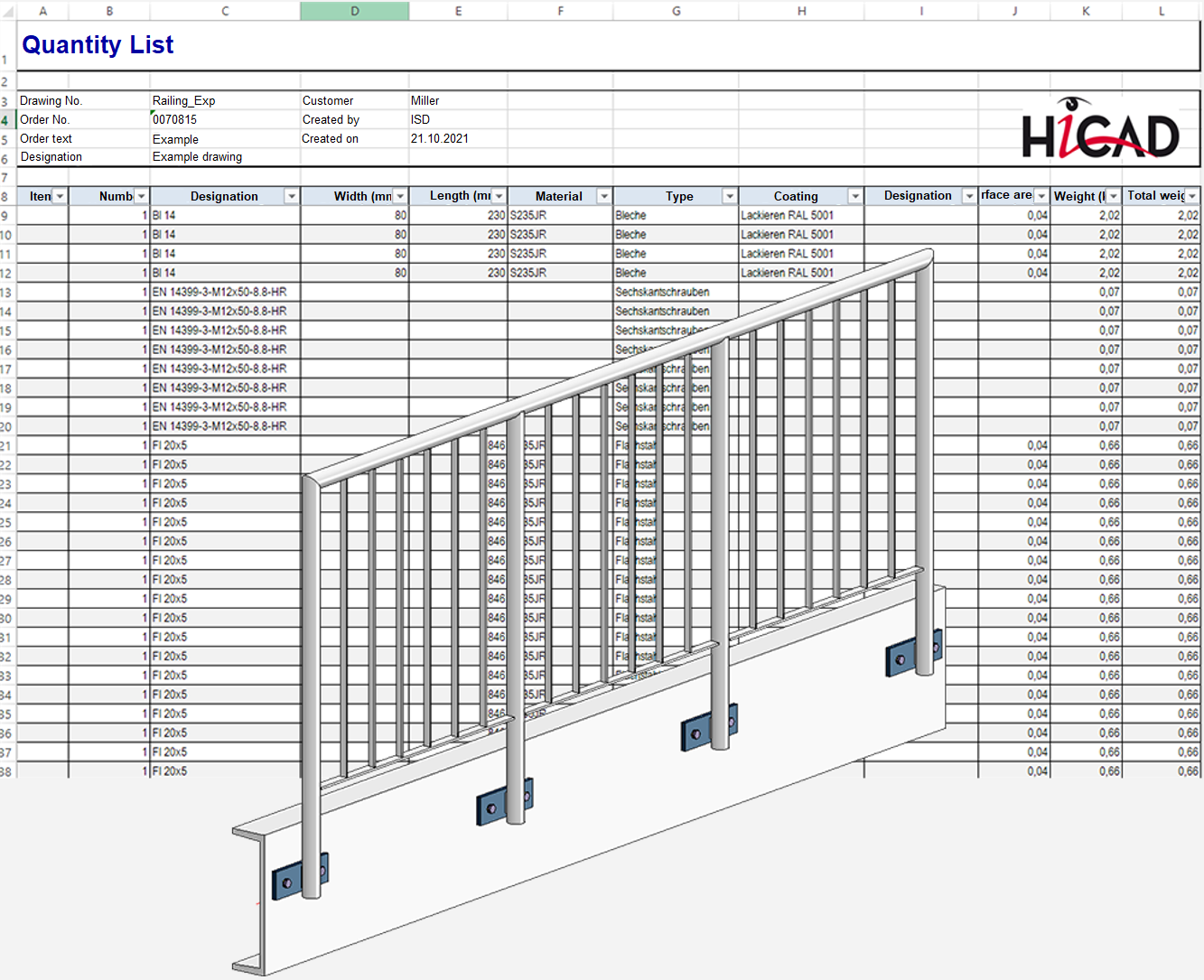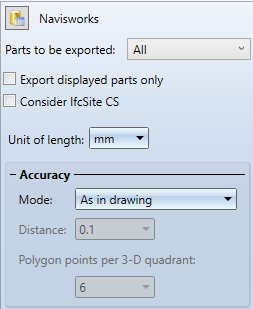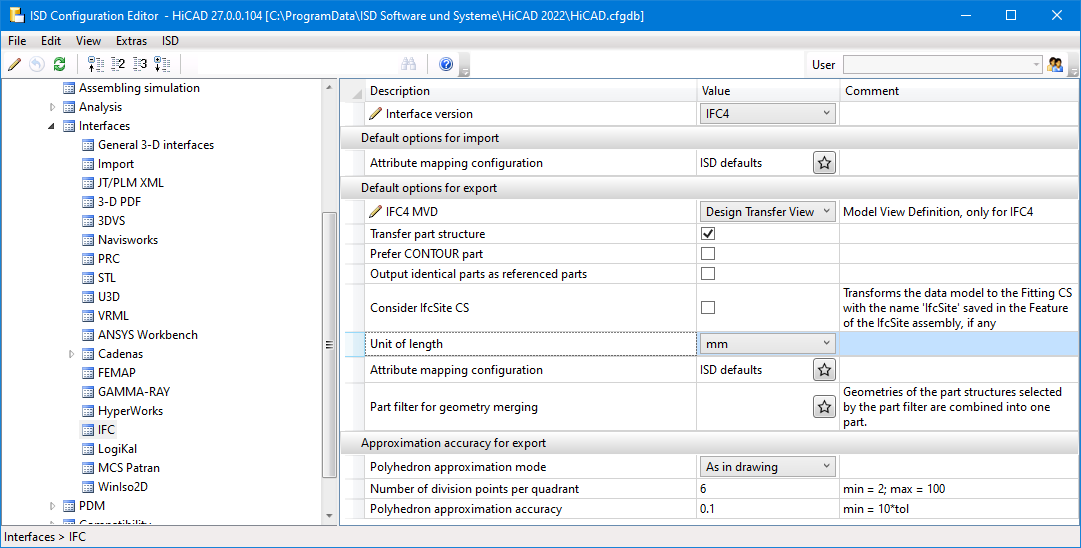Interfaces - What's New?
Service Pack 2 2022 (V 2702)
3-D DXF export
The function 3D-DXF (Approx.) function (via Drawing > Save/Print... > Save as
function (via Drawing > Save/Print... > Save as  > Further... > 3D-DXF (Approx.) is no longer available as of SP2. This function only output a faceted representation, not a complete geometry file! The better alternative is the real 3D DXF export or the export as 3D PDF.
> Further... > 3D-DXF (Approx.) is no longer available as of SP2. This function only output a faceted representation, not a complete geometry file! The better alternative is the real 3D DXF export or the export as 3D PDF.
2-D DXF: Taking into account of units
For both import and export of 2-D DXF files, the possibility of interpreting data in different units has been created.
By default, the units of the DXF file are interpreted during import. When exporting, the data is exported in the HiCAD drawing unit.
Service Pack 1 2022 (V 2701)
PROFLEX-BOMs
PROFLEX® is an ERP software for metal processing..
For the output of PROFLEX®-specific BOMs, the following functions are now available at Drawing > Save/Print.> Save as > Further...:
The BOMs contain certain columns of the Excel BOM for Steel Engineering (HiCAD_Stahlbau*.xlsx) that are specifically relevant for PROFLEX®. The output is in XLSX format. Generated will be the structure list and the quantity list.

IFC import - Representation of beams + profiles
When importing beams and profiles via IFC, the default representation (exact or simplified) defined in the Steel Engineering Settings  function is now taken into account.
function is now taken into account.
SNDF import of Steel Engineering plates
When importing steel engineering plates via the SDNF interface, the default value set on the Weight calculation tab of the Steel Engineering Settings  function was previously used. However, this only applied if a plate existed in the catalogue table Semi-finished products > Plates > Plate for the selected default material. Only then were the plates imported/generated. As of HiCAD 2022 SP1, S235JRG2 is used as the default material for steel engineering plates.
function was previously used. However, this only applied if a plate existed in the catalogue table Semi-finished products > Plates > Plate for the selected default material. Only then were the plates imported/generated. As of HiCAD 2022 SP1, S235JRG2 is used as the default material for steel engineering plates.
Enhancements for export via Spooler
The output via the Spooler has been extended by the formats
-
ToPs GEO (*.geo) and
-
Navisworks (*.nwc and *.nwd); however, the export as .nwd file is only possible if a licensed version of Navisworks is available on the Spooler server.
With the Navisworks export via the Spooler - as with other formats - the entire model drawing is exported.
The ToPs GEO export only exports sheet developments or developments of sheets that exist in the drawing.
Major Release 2022 (V 2700)
Update to CADfix 12 SP2
With the update to CADfix 12 SP1, interfaces to the following format versions are now available in HiCAD 2022:
- ACIS 2021 1.0 (R31)
- CATIA V5 V5-6 R2021
- DWG 2021
- DXF 2021
- Inventor 2021
- JT 10.8
- PLM XML 10.8
- Parasolid 33
- SOLIDWORKS 2021
- NX 1953 Series
Navisworks - Export
Export to Navisworks was previously only possible via the HiCAD API. From HiCAD 2022, designs and parts can also be exported to nwc and nwd format using the function 3-D formats (STEP, IFC, 3D PDF ...). Please note that exporting as an nwd file is only possible if a licensed version of Navisworks is available on the computer.
After calling up the function, select the desired file type. On the right in the dialogue window you can then specify the options for the export.

The settings can be preset in the Configuration Editor at Interfaces > General 3-D Iinterfaces > Navisworks and Interfaces > Navisworks.
IFC-Import - BOM-relevance
Until now, the BOM-relevance of parts and assemblies was automatically removed when importing IFC files. From HiCAD 2022, an additional checkbox can be used to specify whether the attribute BOM-relevant should be assigned to the imported parts and assemblies or not.

This can be useful, for example, if a model drawing is started in a staircase program and is then to be completed in HiCAD.
IFC-Export - Reference View
For the interface version IFC4, the export as Reference View is also supported for the IFC export from HiCAD 2022. For this purpose, the setting Model View Definition is available in the dialogue window for the IFC export. However, this is only visible if you have selected the interface version IFC4 in the Configuration Editor at Interfaces > IFC.


In this case you can select in the Model View Definition field which definition is to be used for the export as IFC data model.
- Design Transfer View
This is the default setting for the IFC export. In contrast to the Reference View, where the exported model should not be changed, it is possible to make changes to the exported model when exporting via IFC4 Design Transfer View. - Reference View
This setting assumes that the exported model is not to be changed. This makes sense if the exported model is only to be used for pure coordination purposes, e.g. for visualisation, collision detection, quantity takeoff, etc., and therefore no absolutely exact geometry is required. The geometry is represented "simplified" here, i.e. simple geometry with extrusions only, complex geometry as a tessellated polygon mesh. With this definition, there are also fewer compatibility problems in the IFC management programs than with the IFC 4 Design Transfer View.



